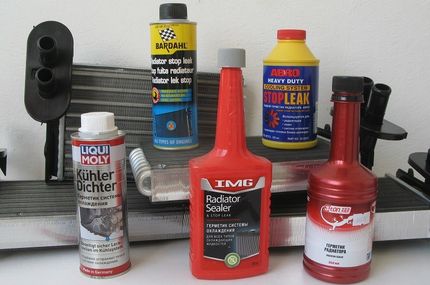
Radiator sealant - should I use it for a coolant leak?
Content
Radiator leaks can be dangerous - they can damage the head gasket or overheat the engine. If you notice that the coolant in the expansion tank is running out, do not underestimate this matter. You can fix small leaks with a radiator sealant. In today's post, we suggest how to do this and whether such a solution would be sufficient in every situation.
What will you learn from this post?
- Should you use a radiator sealant?
- How to use radiator sealant?
- What kind of damage can a radiator leak lead to?
Shortly speaking
Radiator Sealant is a preparation consisting of aluminum microparticles that detects a leak and fills it, sealing the leak. It is added to the coolant. Sealants can be used in all types of coolers, but remember that this is a temporary help - no agent of this type will seal cracks or holes permanently.
Help, leak!
Agree - when was the last time you checked the coolant level? Although engine oil is regularly checked by every driver, it is rarely mentioned. An insufficient amount of coolant is signaled only by the on-board computer. If the characteristic "thermometer and wave" light comes on on the dashboard, be sure to check the coolant level and add it. To find out if the defect is caused by normal wear or leakage in the cooling system, mark the actual amount of coolant on the expansion tank. After driving several tens of kilometers, check again - subsequent losses indicate that there is a leak in some element of the cooling system.
Radiator Sealant - Temporary Emergency Help
In case of small leaks, radiator sealant will provide immediate assistance. This medication contains mikrocząsteczki aluminumwhich, when added to the coolant, "fall" into leaks, for example from pebbles or edge cracks, and clog them. Sealants they do not affect the properties of the coolant and do not interfere with the operation of the radiator. Their use is also extremely simple. It is enough to start the engine for a moment to warm it up a little (and the word “gently” is very important here - there is a risk of burns), and then turn it off, add the drug to the expansion tank and restart the car. The sealant should seal any leaks after about 15 minutes. If there is not enough coolant in the system, it must be topped up before using the product.
Products from trusted companies such as K2 Stop Leak or Liqui Moly are mixed with any type of coolant and can be used in all coolers, including aluminum ones.

Of course, radiator sealant is no miracle. This is a special help that is useful, for example, on the road away from home or on vacation, but which one? works only TEMPORARILY... There is no need to visit a mechanic and properly check the cooling system.
It is worth emphasizing that the seal will only work if there is a leak in the metal core of the radiator... Other elements such as expansion vessel, piping or housing parts cannot be sealed in this way because they have too much thermal expansion.
Radiator sealant is exactly the same as tire sealant - don't expect it to work wonders, but it's worth it. On the site avtotachki.com you can find drugs of this type, as well as fluids for radiators or engine oils.
Also check:
Can radiator fluids be mixed?
Is the radiator damaged? Check out what the symptoms are!
How to fix a leaky radiator? #NOCARadd
